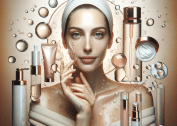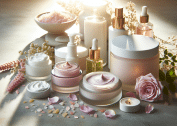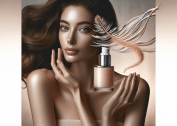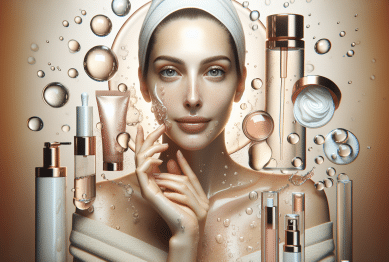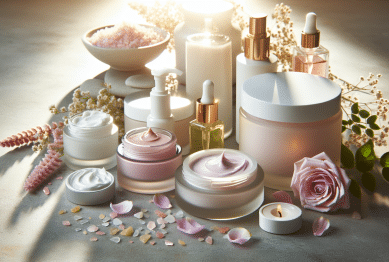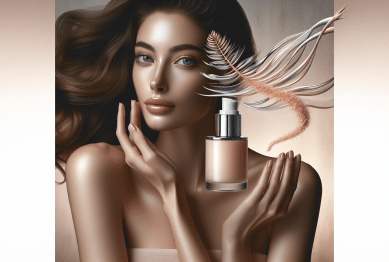Unlock the science and daily rituals behind truly radiant skin. This guide explores glowing skin, skincare routines, hydration secrets, nutritional tips, and the role of sleep and stress in beauty, all woven together for an inside-out approach to lasting wellness.
The Science Behind Glowing Skin
Radiant skin isn’t just about appearance—it reflects inner health. Dermatologists often emphasize the relationship between cellular turnover and hydration when explaining how skin glows. As dead skin cells shed and new ones rise to the surface, the complexion naturally appears more luminous. But this process is sensitive to both internal and external factors. Changes in diet, stress, sleep, and exposure to pollutants can slow down skin renewal or compromise the skin’s moisture barrier, leading to dullness. Using gentle exfoliation—for example, with mild alpha hydroxy acids—can accelerate turnover and foster a smoother, more vibrant surface. But over-exfoliating brings its own risk. Balance is key, as overdoing it may actually compromise skin strength and elasticity.
Hydration is foundational for achieving glowing skin. Without ample water both inside and out, the skin’s uppermost layers become rough and lose their ability to reflect light. When skin is thirsty, fine lines are more pronounced and topical products don’t absorb as well. Moisturizers that blend humectants (which draw in water) and emollients (which lock in hydration) can make a visible difference. While drinking water assists overall skin function, research indicates that a consistent skincare routine that prioritizes gentle cleansing and regular moisturizing is equally important for a healthy glow (https://www.aad.org/public/diseases/a-z/skin-care-basics).
Environmental aggressors can sap skin of radiance by triggering oxidative stress. Ultraviolet (UV) light, pollution, and even artificial blue light are culprits. Investing in antioxidants such as vitamin C, both orally and topically, helps fortify skin’s defenses and neutralize free radicals. There’s growing enthusiasm for niacinamide and green tea extract as daily-use ingredients for skin brightness. They work together to minimize redness, smooth out texture, and help create the ever-elusive ‘lit from within’ effect. Incorporating both physical protection and these advanced serums delivers resilience that helps skin recover and thrive.
Building a Daily Skincare Routine
Establishing a skincare regimen may sound daunting, but it’s about committing to brief, consistent daily habits. Start with a gentle cleanser—one that removes impurities but doesn’t strip natural oils. Experts suggest massaging skin for around a minute to boost circulation and help clear away dull surface debris. Cleansers with hydrating and soothing botanicals, like aloe or chamomile, offer an extra touch of calm. Morning and night, this ritual lays the foundation for all the care that follows. Even if skin seems clear, regular cleansing helps prevent buildup that might otherwise dull the complexion over time.
After cleansing, products should be layered according to texture—lightest first. Think serums, followed by creams and then the all-important sunscreen during daytime. Vitamin C serums are lauded for evening skin tone and supporting collagen, while hyaluronic acid-based serums restore and bind moisture. Moisturizers seal these steps, balancing hydration and strengthening skin’s natural barrier. Without this critical sealing step, water can evaporate rapidly from skin, making even the best serums less effective (https://www.ncbi.nlm.nih.gov/pmc/articles/PMC5796020/).
No routine is complete without sun protection, regardless of climate or skin type. Dermatologists recommend a broad-spectrum sunscreen rated SPF 30 or higher, applied daily. Even during overcast days, UVA rays break through and accelerate skin aging. Incorporating sunscreen not only reduces the risk of skin damage, but it also preserves luminosity by defending against pigment changes and loss of elasticity. This single step, often overlooked, can make the difference between vibrant skin and premature aging. Stay consistent. Your skin will thank you for it.
Hydration and Its Surprising Impact
Hydration plays a starring role in any glowing skin story. Water accounts for roughly 64% of the skin’s outermost layer. If the body is dehydrated, the skin won’t look its best—even if every other skincare step is perfect. It’s common to underestimate the effect a single extra glass of water can make. Dehydration can aggravate both dryness and oiliness as the body scrambles to balance itself. Sometimes, people with oily skin avoid moisturizer, only to find their oiliness increases. That’s the paradox: hydrated skin often produces less excess oil. Topical hydration, using products like serums with glycerin or panthenol, helps replenish what’s lost to the environment every day. Think of it as laying down protective armor before stepping out.
Your diet can also affect how your skin retains moisture. Omega-3 rich foods, such as walnuts or salmon, support plumpness and elasticity from within. Some studies suggest that replacing sugary beverages with water can improve skin clarity by helping flush away internal toxins. Additionally, drinking herbal teas like green tea brings added antioxidant benefits alongside hydration (https://www.hsph.harvard.edu/nutritionsource/vitamins/vitamin-e). Small, sustainable changes here can have surprising ripple effects throughout your complexion.
Beyond what you drink, how you care for your skin matters, too. Humidifiers can combat dry air—especially during winter or in air-conditioned spaces. Environmental stressors are kept in check by regularly refreshing the skin with thermal water sprays or gentle hydrating mists. These not only alleviate tightness but also instantly revitalize tired-looking faces. Layering multiple hydration methods—internal and external—establishes a true moisture reservoir, helping skin reflect light naturally and maintain its bouncy feel.
Nourishing Skin with the Right Nutrition
Eating a rainbow of fresh, colorful fruits and vegetables does more than fuel the body—it’s a direct investment in skin wellness. Carotenoids like beta-carotene, found in carrots and sweet potatoes, act as natural antioxidants within the skin. These compounds help defend against free radical damage as well as environmental stress. Incorporating berries, rich in vitamin C, further supports the synthesis of collagen—a protein crucial for firmness and elasticity. Developing a skin-supportive diet is less about restriction and more about making smart, consistent choices. Incorporating a handful of nuts or seeds each day can also add zinc and selenium, trace minerals touted for their complexion-brightening qualities.
Protein matters too. Collagen is the most abundant protein in human skin, and its gradual loss is a key factor in visible aging. Including lean proteins such as poultry, fish, beans, or eggs supports natural regeneration. There is also ongoing research into collagen peptide supplements, suggesting potential benefits for elasticity and hydration; however, experts recommend focusing on whole food sources and balanced eating habits as a first step (https://www.niams.nih.gov/health-topics/collagen).
Watch out for ingredients that can sabotage radiance. Excess refined sugar and processed foods spike insulin, sometimes triggering breakouts. Dairy is another debated topic, with some individuals reporting clearer skin after reducing their intake. By tuning into your body over time, it’s possible to identify which foods enhance that glow—and which may be holding it back. Remember, what’s good for long-term overall wellness is often what’s best for your skin.
The Role of Sleep and Stress in Beauty
Skin is often the first place to show signs of a restless night. During sleep, blood flow increases, collagen rebuilds, and cell damage repairs itself. Shortchanging this process, even by an hour or two, can result in a sallow tone and dark circles. Prioritizing deep, restorative rest becomes more than just an energy boost—it’s a powerful, free tool for beauty. Consistent bedtime routines that avoid blue light, heavy meals, and late caffeine intake will help improve sleep quality and skin results. A tip: try winding down with a calming ritual like gentle face massage or quiet reading. Sleep’s renewing power can be seen in brighter, more refreshed skin by morning.
Stress is another stealthy thief of radiance. When the body is anxious or overwhelmed, cortisol levels spike. High cortisol can delay healing, trigger breakouts, and worsen conditions like eczema or rosacea. Incorporating mindfulness practices, yoga, or simply spending time in nature can significantly lower stress markers and benefit both inner and outer health. Studies continue to show a strong connection between chronic stress and premature skin aging (https://www.ncbi.nlm.nih.gov/pmc/articles/PMC5579396/). Building in daily moments of calm is not indulgent—it’s essential self-care for lasting glow.
Finally, the link between sleep, stress, and skin offers hope. Unlike genes or pollution, these are factors within personal influence. Even starting with minor incremental habits, such as a regular bedtime or adopting deep breathing during busy days, can yield visible results. As these new patterns solidify, the cumulative benefits become increasingly noticeable, making skin brighter and more resilient over time.
Natural Ingredients and Modern Treatments
Nature’s pharmacy is vast and, for many, a trusted starting point in the quest for glowing skin. Aloe vera, honey, and turmeric have centuries of tradition. Aloe hydrates and soothes, while honey acts as both a humectant and gentle exfoliant. Turmeric is coveted for its anti-inflammatory and brightening effects. These time-honored remedies are easy to incorporate as single-ingredient masks or spot treatments. However, it’s always wise to test new substances on small skin areas and observe reactions. Natural doesn’t always mean irritation-free, so take a balanced, informed approach to find what suits you best.
Meanwhile, advances in dermatology introduce treatments such as light therapy, chemical peels, and fractional lasers—all designed to jumpstart radiance from the deeper layers. These treatments target concerns like discoloration, fine lines, and uneven texture, providing faster results than traditional at-home methods. Consulting with a board-certified professional ensures the right match for individual skin concerns and reduces the risk of adverse effects (https://www.aad.org/public/cosmetic/fillings/skin-rejuvenation-chemical-peels).
Combining nature-inspired ingredients with doctor-led interventions is not only possible but also increasingly common. Many brands now formulate with botanical extracts alongside evidence-based actives, offering holistic solutions. Ultimately, building a radiant complexion is about being gentle and consistent, staying curious, and making informed choices. Whether one prefers the simplicity of the kitchen cupboard or the precision of a dermatologist’s office, glowing skin is within reach for those who approach their routines with patience and care.
References
1. American Academy of Dermatology. (n.d.). Skin care: Tips for healthy skin. Retrieved from https://www.aad.org/public/diseases/a-z/skin-care-basics
2. Draelos, Z. D. (2018). The science behind skin care: Moisturizers. Retrieved from https://www.ncbi.nlm.nih.gov/pmc/articles/PMC5796020/
3. Harvard T.H. Chan School of Public Health. (n.d.). Vitamin E. Retrieved from https://www.hsph.harvard.edu/nutritionsource/vitamins/vitamin-e
4. National Institute of Arthritis and Musculoskeletal and Skin Diseases. (n.d.). Collagen: What it is, types, and uses. Retrieved from https://www.niams.nih.gov/health-topics/collagen
5. Slominski, A. T., & Zmijewski, M. A. (2017). How does stress affect the skin? Retrieved from https://www.ncbi.nlm.nih.gov/pmc/articles/PMC5579396/
6. American Academy of Dermatology. (n.d.). Chemical peels: Overview. Retrieved from https://www.aad.org/public/cosmetic/fillings/skin-rejuvenation-chemical-peels


